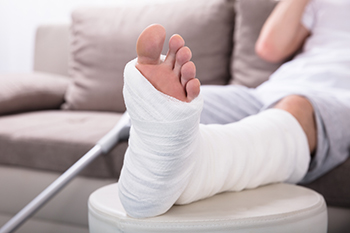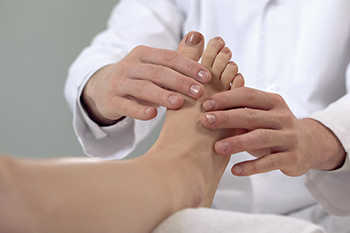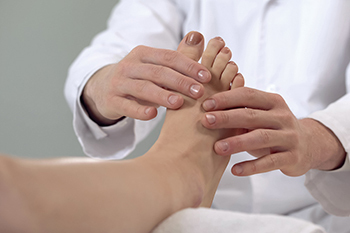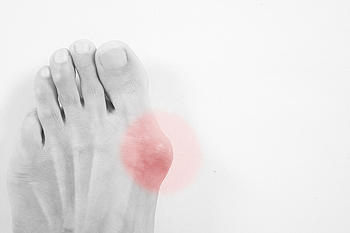Dr. Kennan T. Runte, DPM, FACFAS
Dr. Panah Nabili, DPM
Grass Valley, CA 95945
Dr. Kennan T. Runte, DPM, FACFAS
Dr. Panah Nabili, DPM

A broken ankle, which is also referred to as a fractured ankle, can occur as a result of a fall, or if an injury has happened. The ankle is divided into three categories, and any one or more of these bones can become fractured. The larger bone in the lower leg is called the tibia, and the fibula refers to the smaller bone in the lower half of the leg.The bone that is located between the heel bone, the tibia and the fibula is known as the talus. A broken ankle is often noticeable and there is generally pain and discomfort that can accompany it. Patients can find it difficult to walk on, and there may be bruising and swelling. Many broken ankles can be treated by wearing a cast or a boot, and this can provide the stability that is needed as the healing process occurs. A protruding ankle bone often indicates a severely broken ankle, and surgery may be necessary that may restore normal functioning. If you have broken your ankle, please speak to a podiatrist as quickly as possible who can effectively diagnose and treat it.
If you are having discomfort in your feet and would like to try orthotics, contact one of our podiatrists from Foothill Podiatry Clinic. Our doctors can provide the care you need to keep you pain-free and on your feet.
What Are Orthotics?
Orthotics are inserts you can place into your shoes to help with a variety of foot problems such as flat feet or foot pain. Orthotics provide relief and comfort for minor foot and heel pain but can’t correct serious biomechanical problems in your feet.
Over-the-Counter Inserts
Orthotics come in a wide variety of over-the-counter inserts that are used to treat foot pain, heel pain, and minor problems. For example, arch supports can be inserted into your shoes to help correct overarched or flat feet, while gel insoles are often used because they provide comfort and relief from foot and heel pain by alleviating pressure.
Prescription Orthotics
If over-the-counter inserts don’t work for you or if you have a more severe foot concern, it is possible to have your podiatrist prescribe custom orthotics. These high-quality inserts are designed to treat problems such as abnormal motion, plantar fasciitis, and severe forms of heel pain. They can even be used to help patients suffering from diabetes by treating foot ulcers and painful calluses and are usually molded to your feet individually, which allows them to provide full support and comfort.
If you are experiencing minor to severe foot or heel pain, it’s recommended to speak with your podiatrist about the possibilities of using orthotics. A podiatrist can determine which type of orthotic is right for you and allow you to take the first steps towards being pain-free.
If you have any questions please contact our office located in Grass Valley, CA . We offer the newest diagnostic and treatment technologies for all your foot and ankle needs.

Neuropathy is nerve damage that can arise from varied causes. Peripheral neuropathy is damage to the peripheral nerves, and it often affects the lower extremities. It can be experienced as numbness, tingling, or sharp pains in the feet. One might have trouble maintaining their balance, muscle spasms, or muscle weakness. The affected area may feel hot. If left untreated, this condition can hinder quality of life. Those with diabetes, HIV, stroke, high blood pressure, and autoimmune diseases are among those most at risk for this affliction. Accidents, infections, or vitamin deficiencies can also lead to nerve damage. Smoking and drinking can lead to a higher incidence of peripheral neuropathy as well. Lifestyle changes, such as in diet and exercise, can slow down or reverse symptoms and the progression of such nerve damage. The earlier peripheral neuropathy is caught, the better the diagnosis. So it is suggested that you consult with a podiatrist as soon as symptoms are felt.
Neuropathy
Neuropathy can be a potentially serious condition, especially if it is left undiagnosed. If you have any concerns that you may be experiencing nerve loss in your feet, consult with one of our podiatrists from Foothill Podiatry Clinic. Our doctors will assess your condition and provide you with quality foot and ankle treatment for neuropathy.
What Is Neuropathy?
Neuropathy is a condition that leads to damage to the nerves in the body. Peripheral neuropathy, or neuropathy that affects your peripheral nervous system, usually occurs in the feet. Neuropathy can be triggered by a number of different causes. Such causes include diabetes, infections, cancers, disorders, and toxic substances.
Symptoms of Neuropathy Include:
Those with diabetes are at serious risk due to being unable to feel an ulcer on their feet. Diabetics usually also suffer from poor blood circulation. This can lead to the wound not healing, infections occurring, and the limb may have to be amputated.
Treatment
To treat neuropathy in the foot, podiatrists will first diagnose the cause of the neuropathy. Figuring out the underlying cause of the neuropathy will allow the podiatrist to prescribe the best treatment, whether it be caused by diabetes, toxic substance exposure, infection, etc. If the nerve has not died, then it’s possible that sensation may be able to return to the foot.
Pain medication may be issued for pain. Electrical nerve stimulation can be used to stimulate nerves. If the neuropathy is caused from pressure on the nerves, then surgery may be necessary.
If you have any questions, please feel free to contact our office located in Grass Valley, CA . We offer the newest diagnostic and treatment technologies for all your foot care needs.

The coronavirus brought times to the world where children were homeschooled, and time was limited for physical activities because of threatening germs. The type of shoes children wore were often overlooked as shoe stores were closed and new shoes were rarely purchased. As current times are upon us and children have returned to school, the first step in choosing the correct shoes for your child generally starts with getting the right shoe size. This is done by properly measuring the foot using a Brannock device, which is found in most shoe stores. The type of shoe that is desired is often considered, in addition to the material that it is made from, if they are lightweight, and have protection and flexibility. And lastly, the shoes need to fit comfortably from the moment they are tried on and should not need a break in period. Children that live in various climates and environments typically will wear different types of shoes and how long the shoes are worn is often considered. If you have questions about what type of shoes your children should wear, please schedule an appointment with a podiatrist.
The health of a child’s feet is vital to their overall well-being. If you have any questions regarding foot health, contact one of our podiatrists of Foothill Podiatry Clinic. Our doctors can provide the care you need to keep you pain-free and on your feet.
Tips for Keeping Children's Feet Healthy
If you have any questions, please feel free to contact our office located in Grass Valley, CA . We offer the newest diagnostic and treatment technologies for all your foot care needs.

The common foot condition known as a bunion can be unflattering. It is a deformity that affects approximately 30% of the population. A bunion is defined as a bony lump that forms on the side of the big toe. Research has shown it can develop from genetic reasons or possibly from the shoes that are worn. Many people wear shoes that do not have adequate room for the toes to move freely in, and a bunion may start to form. Additional reasons why a bunion can occur include enduring an injury that may alter the structure of the foot. This may contribute to having damaged ligaments, and can cause a misalignment of the big toe. If the bunion is large, it may cause the big toe to shift toward the other toes, and this can cause pain and discomfort. Patients often need to purchase larger shoes that can accommodate the bunion, and it is suggested that medical attention is sought. There are several treatment options for bunions, and if you are afflicted with one, it is strongly advised that you contact a podiatrist who can guide you toward the best one for you.
If you are suffering from bunion pain, contact one of our podiatrists of Foothill Podiatry Clinic. Our doctors can provide the care you need to keep you pain-free and on your feet.
What Is a Bunion?
Bunions are painful bony bumps that usually develop on the inside of the foot at the joint of the big toe. As the deformity increases over time, it may become painful to walk and wear shoes. Women are more likely to exacerbate existing bunions since they often wear tight, narrow shoes that shift their toes together. Bunion pain can be relieved by wearing wider shoes with enough room for the toes.
Causes
Symptoms
In order to diagnose your bunion, your podiatrist may ask about your medical history, symptoms, and general health. Your doctor might also order an x-ray to take a closer look at your feet. Nonsurgical treatment options include orthotics, padding, icing, changes in footwear, and medication. If nonsurgical treatments don’t alleviate your bunion pain, surgery may be necessary.
If you have any questions, please feel free to contact our office located in Grass Valley, CA . We offer the newest diagnostic and treatment technologies for all your foot care needs.